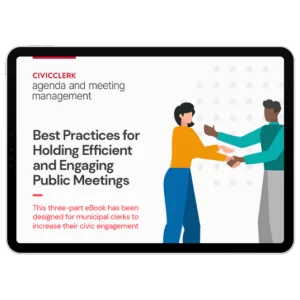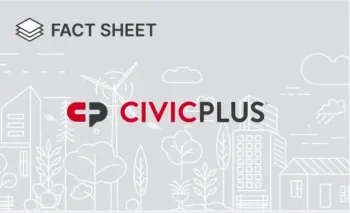10 Best Practices to Enhance Your Public Meetings
Many local governments have had to change how they operate over the last year. Due to COVID-19 and maintaining social distance, public meetings have gone virtual or a hybrid of virtual and in-person. With this in mind, we’ve compiled the ten best practices to enhance your meetings, which you can apply to virtual meetings and in-person meetings.
1. Pre-Meeting Communication
It is good practice to post a schedule of regular and special meetings in one central location. The meeting notice should include a set schedule of times and days you inform your residents about your meeting.
- First messaging: Two weeks before your meeting
- Second messaging: One week before your meeting
- Third messaging: One day before
Bonus tip: Don’t forget to add context to your meeting information. By mentioning hot topics, you’ll help draw residents into the discussion. For example: Instead of posting: “City council meeting tonight at 8 p.m.,” consider posting details like: “At tonight’s city council meeting, we’ll be discussing important information about the local dog park ordinance. Be there at 8 p.m. to provide your input.”
2. Post Your Meetings on Multiple Channels
The more channels you post your public meeting notice, the more likely residents will see the information.
- Post on your official government organization website
- Share on all social media accounts, including YouTube
3. Automated Notifications
We recommend you leverage tools like automated notifications to push out meeting notifications directly. Today, most local government websites should have an email subscription functionality; if yours does not, it may be time to switch. Choose an agenda and meeting management system to enable residents to sign up for notifications about meetings and other events of interest. Promote your email subscription option during meetings, on social media, and your website.
4. Allow for Different Types of Participation
Technology affords government organizations more ways to connect with residents than ever before. With limited time and increasing digital options, residents choose how they want to connect with their local government. Providing multiple methods of access lets the public know their participation is valued.
5. In-meeting Visual Display
If you use a meeting and agenda management solution, you might have the option to display the events of the meeting, in real-time, on video screens right in the meeting chamber. The public can follow along with agenda items, key discussion points, public comments and voting.
Bonus tip: If you conduct your meeting virtually, you can share the same page via screen share on most teleconferencing software such as Zoom or Go-To-Meeting.
6. Digital Live Voting
Take advantage of your meeting management solution’s live voting feature. The feature allows users to show the legislators casting votes live directly from their own Mac, PC, iPad, or Android Device. Display voting results in real-time. This feature increases transparency for the community, improves staff efficiency when recording voting results in the meeting minutes, and simplifies voting for elected officials.
7. Live Streaming
Live stream your meeting for public viewing, allowing thousands of participants without any chance of disruption to your meeting. In addition, your meeting videos can be closed captioned to increase accessibility for your community.
There are multiple options for live streaming:
- YouTube – Free to use; integrates with Zoom
- Vimeo – Low cost, but more control over your video presentation
- Third-party streaming solutions – These require a more significant financial investment but also allow for more flexibility and additional features
8. Post-Meeting Communication
Even well-attended meetings only reach a small segment of the community who require information or whose input could be valuable in crafting solutions. Send and post meeting items quickly and consistently after meetings.
- Have a designated place on your municipal website for posting minutes, audio, and video recordings.
- Post them as quickly as possible after your meeting.
- Use automatic notifications to update the public, elected officials, and staff when they are available.
9. Public Meetings Portal
Utilize the mini-website that your public meeting provider should provide.
The portal shows all content in one central location to find everything:
- Agendas
- Agenda Packets
- Minutes
- Videos
- View a live stream of the current meeting alongside your agenda packet
- After the meeting, residents can watch a video recording of the meeting with a time-stamped copy of the agenda
10. Integrations to Improve Transparency
Many meeting and agenda management solutions lack integrations for local governments. However, Municode Codification from CivicPlus® enables local governments to automatically send newly adopted legislation between our Agenda and Meeting Management software and our online code hosting solution. Users may select ordinances from completed meetings and have them immediately show on the webpage of their online code. Once codified, the history note referencing the ordinance will link back to the meeting detail page containing the audio, video, and supporting agenda documents specific to the meeting during which your council discussed the ordinance.
These tips and tricks will help you and your community get the most out of your time, whether preparing for effective meetings. These meetings don’t have to be daunting, and we hope these practices have helped you better prepare for your local government public meetings. Take a self-guided video tour of our Agenda and Meeting Management software for clerks to see what it can do for you.



